Media | Articles
The most track-capable Corvettes from every generation
Hot off an amazing first drive of the new Corvette Z06, and in recognition of the marque’s place as one of the most popular choices among Hagerty clients, we thought it’d be a good moment to throw a little light on America’s sports car.
America’s sports car, like America itself, has almost always been astounding in its diversity. Although it has never strayed from the basic two-seater concept, Corvette’s mile-wide option list has consistently fostered a broad swath of enthusiasts, from the cruiser crowd sporting convertibles with smooth-shifting automatics to horsepower addicts letting loose their roaring big-blocks and subsequent supercharged monsters.
To say this formula has worked would be a joke of an understatement—the Corvette, despite typically being the more pricey of the two, barely trails the Mustang as the most popular car Hagerty insures. A consequence of the everyman appeal is that the Corvette’s reputation has in some circles been more defined by its presence on the boulevard than the marque’s truly rich motorsports history.
And yet, within the broad mix of Corvettes, there have almost always been track-focused models. Many wear famous badges—“Grand Sport,” “Z06”–while others are buried in an alphabet soup of Chevrolet order codes. A few are high-dollar collectibles, but many remain undervalued to this day.
In honor of the debut of the latest and greatest of race-ready Corvettes, the 2023 Z06, we’re looking back at its track-focused predecessors.
Marketplace
Buy and sell classics with confidence
First generation (1953–1961): Can you code?
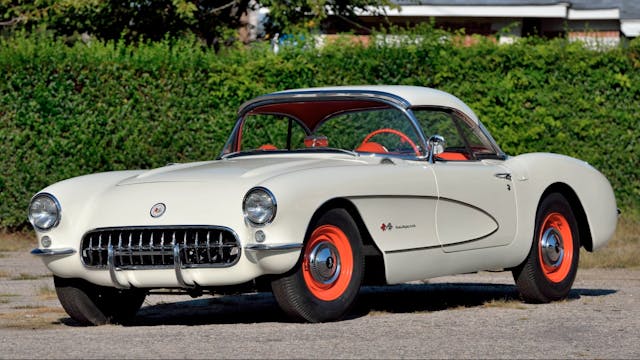
It’s become a trope in articles about the Corvette to note that the first one kind of stunk. Having driven a ’54 with a Blue Flame Six, I’d say that’s unfair or, at the very least, imprecise. It’s a gorgeous piece of retro-futurism that drove at least as well as American passenger cars of its day, which was really the point. Remember that General Motors in the 1950s and at most other points in its history has been a design-first company; its sports cars, from this first Corvette through the Pontiac Fiero and even the fifth-generation Camaro, almost always tend to look better than they drive upon their debut.
The miracle of the C1 Corvette—and the reason the car survived its first decade—was Zora Arkus-Duntov. The engineer, himself a European import, joined GM in 1953 and almost immediately began stuffing Chevy’s Motorama car with mechanicals that made it capable of running with Mercedes and Jaguar. By the late 1950s, small-block V-8-powered Corvettes were fixtures at Daytona and Sebring. Factory-prepped first-generation Corvettes even won their class at LeMans in 1960.
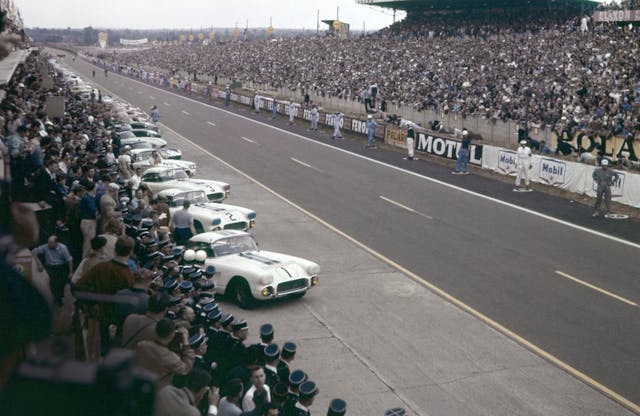
Racing C1 Corvettes tend toward unobtainable, particularly when there’s a name like Cunningham associated with them. To give you an idea, check out our auction report on one of those Le Mans cars. Missing many of its original components and in need of a complete restoration, it nevertheless brought $758,500 at Amelia Island last year.
Fortunately, many of the improvements Arkus-Duntov and crew developed for the track made it to the street as “regular production options.” For instance, checking RPO 684 in 1957 netted heavy-duty brakes and suspension, and RPO 449 got you a so-called “Duntov cam.” The right combination of options transformed early Corvettes into what Chevy advertisements of the day proclaimed to be ”The Real McCoy,” and today bring serious money. For instance, one sold at Mecum Kissimmee earlier this year with several choice RPOs brought $440,000.
First-generation Corvettes would in many ways be eclipsed by the high-performance machines to come in the ensuing decades. Yet in the late 1950s, Corvettes dominated their class in SCCA racing. More important, the car’s achievements in competition directly fed performance improvements on the street. In that sense, C1 Corvettes were the ultimate track cars.
Second-generation (1963–1967) — Grand and sporty
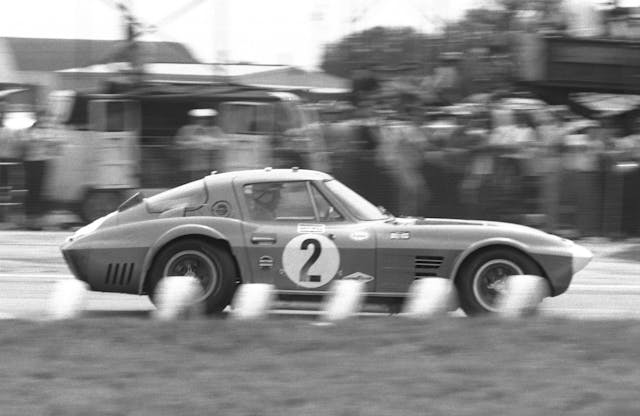
Second-generation Corvette race cars suffered from a case of bad timing. I don’t mean distributor adjustment—rather, GM’s execs adhered more closely than others in Detroit to the 1957 Automobile Manufacturer’s Association ban on corporate-backed racing, effectively tying one of Zora’s arms behind his back. Only 199 race-prepped Z06-package Corvettes made it out the factory door, and the package disappeared after 1963. Even the ultra-rare, lightweight Grand Sports achieved only a few moments of glory in the Bahamas before the suits put the kabosh on things. To add insult to injury, history casts the long shadow of a certain chicken farmer and his Ford V-8-powered AC Ace over the legitimately fast and capable Grand Sports and period Corvette race cars.
Whatever. Sting Rays are awesome. Just sit in a 1963 split-window fuelie—Z06 or not—and listen to the tap-tap-tap of its solid-lifter fuel-injected V-8, and you’ll get it. The collector car market certainly does. Z06 values start just shy of half a million; rare “Big Tank” models, so-named for their optional 36-gallon fuel tanks, usually go for just above that mark. Were one of the competition Grand Sports to hit the open market, it’s safe to say bidding would run well into seven figures.
Third-generation (1968–1982) — Cheap speed
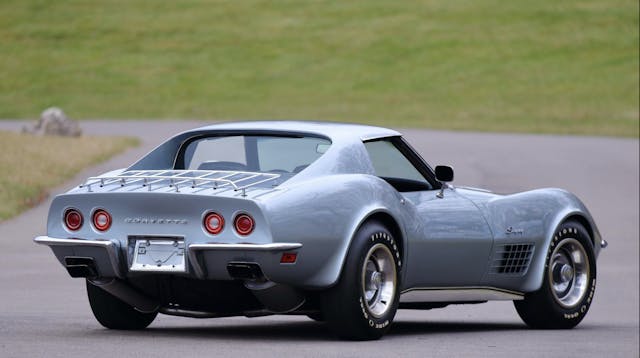
These were the highest production years for the Corvette and they remain plentiful today. Correspondingly, there’s usually more than a few at vintage races—and if you get lucky you’ll see a Greenwood Vette. Naturally, the best and most valuable production performers of the bunch come from early in the car’s long run, before smog controls got their way. The ZR1 package, offered from 1970–72, combined the highest output small-block, the 330-hp LT1, with a close-ratio four-speed and heavy duty suspension. These days those cars can command around $130k—roughly a seventy percent premium over standard LT1 cars. Considering big-block L88 Vettes of the era can command half a million dollars, that’s actually a lot of bang for your buck.
Later third-generation Corvettes offer much less bang: A base 1980 Vette was rated at just 190 hp. Yet the irony is that the very shortcomings of these cars what make them interesting, if unconventional, choices to bring the race track today. Namely, they’re relatively common and, due to their unimpressive performance, remain quite affordable. Excellent examples from the era go for about $30,000. A rough driver—the sort you wouldn’t feel bad about modifying and fitting with a roll cage—can be had for less than ten grand. Before you take to your keyboard to say I’m out of my mind, there’s a Riley-built (yes, of the same Riley Technologies that’s won the Rolex 24 at Daytona 13 times) C3 Corvette that campaigns regularly in the budget-racing Champcar Endurance Series.
Fourth–generation (1984–1996) – The King and its court
My colleague Eddy Eckart has just explained why fourth-gen Vettes remain criminally underrated, so let’s focus here on the practical question of which variant is best suited for track duty. The obvious choice is the 405-hp ZR-1, and it’s not a bad one, considering nice examples can still be had for less than $50,000. Throughout the C4’s run, however, even lesser models were incredibly capable. L98-powered Corvettes so thoroughly dominated their class (and embarrassed the 944 Turbo) in SCCA racing that the league created the standalone Corvette Challenge series. Despite their period performance, they remain downright cheap: a base Corvette from 1992, the debut year for the redesigned, 300-hp small-block V-8, goes for less than $20,000 even in excellent condition. As with all Corvettes, fluency with GM RPO codes can net track goodies: Z51 for heavy duty suspension and bigger brakes (among other things that vary by year), FX3 for adjustable dampers, Z07 in later years for all the above plus some other bits.
I’d be remiss not to mention the last and perhaps the best of the C4s, the 1996 GS, which offered a 330-hp V-8 (called the LT4) along with a stiffer suspension and a rather neat paint scheme that paid homage to those earlier 1960s Grand Sports. Only a thousand were built, though, and a great many of those have been pampered from new, meaning they might be just a bit too nice to exercise regularly on track.
Fifth-generation (1997–2004) — Z06 returns
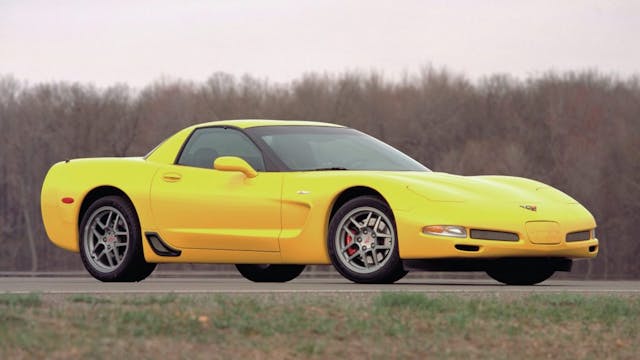
The tip-of-the-spear 2001–2004 Z06 was and remains a performance bargain, what with its 405-hp V-8 (385-hp for 2001), upgraded suspension, and myriad weight-saving measures (most notably a fixed-roof with smaller rear glass). Really nice ones go for about thirty-five grand, which is kind of wild considering that roughly contemporary (and not nearly as capable in stock form) Toyota Supras are going for five times as much.
Yet what makes this generation of Corvette stand out is that it is the first—at least from a modern perspective—that will acquit itself well on track in just about any guise. The car introduced an all-new aluminum-block V-8—the LS1, perhaps you’ve heard of it—and came with a series of handling packages from the get-go. We’d probably look for a fixed-roof coupe, which was slightly more rigid and came standard with the heavy-duty Z51 suspension, but really, it’s hard to go wrong. C5 values bottomed out about four years ago and have since been creeping up, with really nice examples selling for less than $30,000.
Sixth-generation (2005–2013) — Z06, right-sized

Yes, the ZR-1 was the fastest Vette, ever, when it debuted. The Z06, meanwhile, was specifically engineered for track duty and has one of the most memorable modern V-8s—a 7.0-liter that revs with the willingness of a Honda four-cylinder. So why would I suggest the less-powerful, steel-framed Grand Sport? To some degree, it’s a numbers game. The Grand Sport was produced in higher volume than either of the Zs, and surprisingly its production outstripped even the narrow-body base cars from its introduction in 2010 through the end of the C6 in 2013. It’s the less expensive performance variant, and supply means it’s likely to stay that way. If you’re actually looking to visit the track with any regularity, that’s a feature, not a bug.
But I’d also suggest that the Grand Sport is in some respects a right-sized experience. It offers the additional capabilities of Z06-sized brakes and rubber, along with dry-sump oiling and additional fluid coolers. It’s down on power from the LS7, but the LS3 provides plenty of oomph, and with the added grip, the Grand Sport is a little less hairy at the limit that its bigger siblings are known to be. Here’s where I should disclose that I’m by no means a hot shoe. Your tastes and skills may differ. The bigger takeaway is that these early 2000s Vettes come in a variety of highly capable guises. And with the exception of the ZR1, which has rebounded into six figures, they still go for used-luxury-car prices.
Seventh-generation (2014–2019) — Get ’em while they’re used
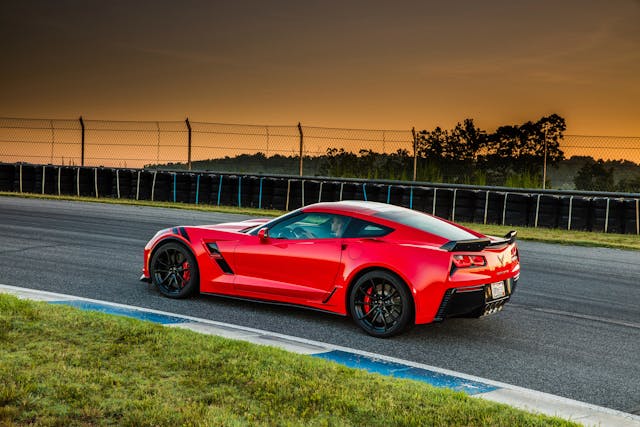
The hottest part of the collector car market at present is so-called “analog” sports cars of the 1990s and early 2000s. The recently-departed C7 Corvette may find itself in that coveted class sooner rather than later. It is, after all, the last Corvette—and likely will be among the last cars, period—to feature a normally aspirated pushrod V-8 up front powering the rear wheels through a manual transmission. What makes this Corvette so clever—and enjoyable to drive on track—is that it actually does employ lots of modern technology, chiefly a computer-controlled rear differential (with the Z51 package) that constantly polishes your driving. The tech works so subtly, and the car is so communicative, that you can simply imagine you’re a more talented version of yourself, while basking in V-8 roar.
Pretty much any C7 with the Z51 package (stiffer dampers, bigger brakes, e-diff) performs amazing feats on track. Higher-spec models take that formula and, to varying degrees, add heaps of downforce, tire, and power. The Z06s of the era, with their supercharged V-8s, have been knocked for overheating on track, although later model years did receive some updates to help matters. Beyond that, however, there’s a simple question of how fast you want to go. If the answer is, ”so, so fast,” there’s a ZR1 ZTK package out there waiting for you, although be warned: they haven’t depreciated. Again, the Grand Sport seems a happy medium for many, pairing much of the Z06’s suspension and aero with a milder normally aspirated V-8. Given that many owners are still making new-car payments on C7s, pricing data on them is much thinner than for earlier models. Yet based on data from Hagerty insurance quotes, it’s safe to say you can find a Grand Sport for around $60,000—slightly less than original MSRP. Just remember to budget for its custom-compound Michelin Pilot Sport Cup tires (more than $2000 a set).
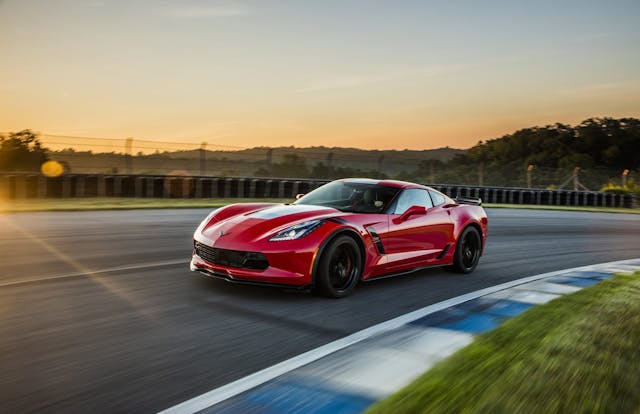






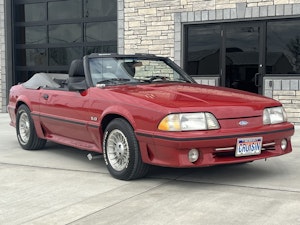







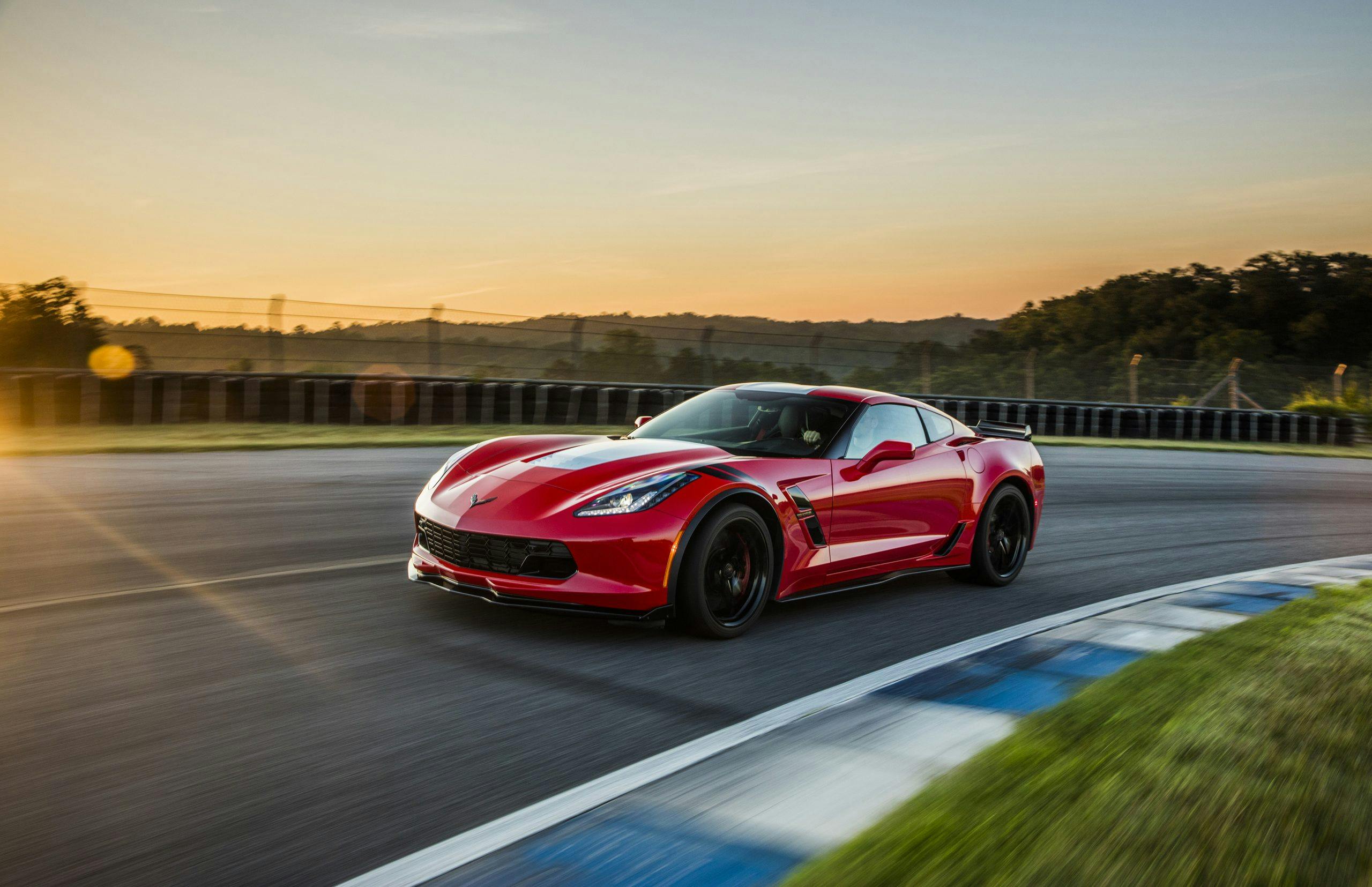
I have owned four Corvette’s. All convertibles. A 1962 300 hp. 327 4 speed. A 1964 365 hp. 327 4 speed. A 1967 350 hp. 327 4 speed. But my 2016 Z51 A8 with magnetic ride control is light years ahead of the rest and is my favorite.
I have owned C-1 to C7 even made a restomod out of the C-1 that was a fun eternity to have. I currently have a 2018 Black Rose GS convertible awesome Vette except for the wheel issue with GM over cast aluminum and an the C-8 forged wheels wheels are cracking and leaking and they will do nothing about it at least I have a beautiful Corvette thanks
Back in the 70’s-80’s…..
Blue, Black interior, 69, 427, 435hp, 3 deuce, 4speed, rag top….
Dang I had fun with that one.
Sure wish I had it now…….